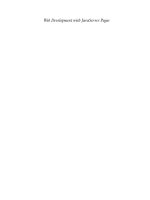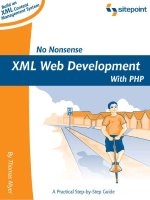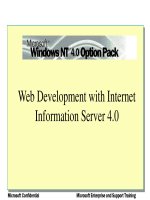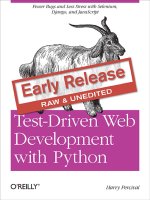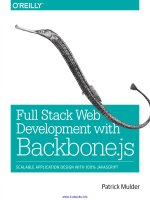Python Web Development with Django pot
Bạn đang xem bản rút gọn của tài liệu. Xem và tải ngay bản đầy đủ của tài liệu tại đây (4.48 MB, 405 trang )
ptg
www.it-ebooks.info
ptg
Python Web Development
with Django
®
www.it-ebooks.info
ptg
informit.com/devlibrary
Developer’s
Library
ESSENTIAL REFERENCES FOR PROGRAMMING PROFESSIONALS
Developer’s Library books are designed to provide practicing programmers with
unique, high-quality references and tutorials on the programming languages and
technologies they use in their daily work.
All books in the Developer’s Library are written by expert technology practitioners
who are especially skilled at organizing and presenting information in a way that’s
useful for other programmers.
Key titles include some of the best, most widely acclaimed books within their
topic areas:
PHP & MySQL Web Development
Luke Welling & Laura Thomson
ISBN 978-0-672-32916-6
MySQL
Paul DuBois
ISBN-13: 978-0-672-32938-8
Linux Kernel Development
Robert Love
ISBN-13: 978-0-672-32946-3
Python Essential Reference
David Beazley
ISBN-13: 978-0-672-32862-6
Programming in Objective-C
Stephen G. Kochan
ISBN-13: 978-0-321-56615-7
PostgreSQL
Korry Douglas
ISBN-13: 978-0-672-33015-5
Developer’s Library books are available at most retail and online bookstores, as well as
by subscription from Safari Books Online at safari.informit.com
Developer’s Library
www.it-ebooks.info
ptg
Python Web Development
with Django
®
Jeff Forcier, Paul Bissex, Wesley Chun
Upper Saddle River, NJ • Boston • Indianapolis • San Francisco
New York • Toro n t o • Montreal • London • Munich • Paris • Madrid
Cape Town • Sydney • Tokyo • Singapore • Mexico City
www.it-ebooks.info
ptg
Many of the designations used by manufacturers and sellers to distinguish their products
are claimed as trademarks. Where those designations appear in this book, and the publish-
er was aware of a trademark claim, the designations have been printed with initial capital
letters or in all capitals.
The authors and publisher have taken care in the preparation of this book, but make no
expressed or implied warranty of any kind and assume no responsibility for errors or omis-
sions. No liability is assumed for incidental or consequential damages in connection with or
arising out of the use of the information or programs contained herein.
The publisher offers excellent discounts on this book when ordered in quantity for bulk pur-
chases or special sales, which may include electronic versions and/or custom covers and
content particular to your business, training goals, marketing focus, and branding interests.
For more information, please contact:
U.S. Corporate and Government Sales
(800) 382-3419
For sales outside the United States, please contact:
International Sales
Visit us on the Web: informit.com/aw
Library of Congress Cataloging-in-Publication Data:
Forcier, Jeff, 1982-
Python web development with Django / Jeff Forcier, Paul Bissex, Wesley Chun.
p. cm.
Includes index.
ISBN-10: 0-13-235613-9 (pbk. : alk. paper)
ISBN-13: 978-0-13-235613-8 (pbk. : alk. paper) 1. Web site development. 2. Django
(Electronic resource) 3. Python (Computer program language) 4. Web sites—Authoring pro-
grams. I. Bissex, Paul. II. Chun, Wesley. III. Title.
TK5105.8885.D54F68 2009
006.7’6—dc22
2008037134
Copyright © 2009 Pearson Education, Inc.
All rights reserved. Printed in the United States of America. This publication is protected by
copyright, and permission must be obtained from the publisher prior to any prohibited repro-
duction, storage in a retrieval system, or transmission in any form or by any means, elec-
tronic, mechanical, photocopying, recording, or likewise. For information regarding permis-
sions, write to:
Pearson Education, Inc
Rights and Contracts Department
501 Boylston Street, Suite 900
Boston, MA 02116
Fax (617) 671 3447
ISBN-13: 978-0-13-235613-8
ISBN-10: 0-13-235613-9
Text prin t ed in the Uni t ed State s o n r ecycle d p aper at RR Donne lley in Craw f ordsvi l le,
Indiana.
First printing October 2008
Editor-In-Chief
Mark Taub
Acquisitions Editor
Debra Williams
Cauley
Development
Editor
Michael Thurston
Managing Editor
Kristy Hart
Project Editor and
Copy Editor
Jovana
San Nicolas-Shirley
Indexer
Cheryl Lenser
Proofreader
Geneil Breeze
Publishing
Coordinator
Kim Boedigheimer
Cover Designer
Gary Adair
Compositor
Jake McFarland
www.it-ebooks.info
ptg
❖
To B r i an L e vi n e, for introducing me to Python, a small
thing that has made a big difference.To my parents,
for allowing me to monopolize the family computer
while growing up. And to my wife, for her loving support
and understanding.
—Jeff Forcier
To my l at e fa t he r H en r y, who taught me to tinker; to my
mother Glenda, who taught me to write; and to my wife
Kathleen, a brilliant star in my life.
—Paul Bissex
To my w on d e r f u l c h il d r en , Leanna Xin-Yi and
Daylen Xin-Zhi, for whom I’ve had to develop multiple
pairs of eyes with which to keep watch over, and who
are miraculously able to temporarily transport me back
in time to remind me of what childhood and its
amazing wonders were like.
—Wesley Chun
❖
www.it-ebooks.info
ptg
Table of Contents
Introduction 1
Where Web Frameworks Come From 1
A Better Way 2
We’re Not in Kansas Anymore 2
Web Development Is Better with Python and Django 3
I: Getting Started
1 Practical Python for Django 7
Python Skills Are Django Skills 7
Getting Started: Python’s Interactive Interpreter 8
Python Basics 10
Comments 10
Variables and Assignment 10
Operators 11
Python Standard Types 11
Object Boolean Values 12
Numbers 12
Numeric Operators 13
Numeric Built-in and Factory Functions 14
Sequences and Iterables 14
Lists 17
Strings 19
Sequence Built-ins and Factory Functions 25
Mapping Type: Dictionaries 26
Standard Type Summary 28
Flow Control 28
Conditionals 29
Loops 29
Exception Handling 30
The
finally Clause 31
Throwing Exceptions with raise 32
Files 33
Functions 34
www.it-ebooks.info
ptg
Declaring and Calling Functions 34
Functions Are First-Class Objects 36
Anonymous Functions 38
*args and **kwargs 40
Decorators 42
Object-Oriented Programming 44
Class Definitions 44
Instantiation 45
Subclassing 46
Inner Classes 46
Regular Expressions 47
The
re module 47
Searching Versus Matching 48
Common Gotchas 48
Single-Item Tuples 48
Modules 48
Mutability 50
Constructor Versus Initializer 52
Coding Style (PEP 8 and Beyond) 53
Indent Four Spaces 53
Use Spaces and Not Tabs 53
Don’t Write Single-Line Suites
on the Same Line as the Header 54
Create Documentation Strings
(aka “docstrings”) 54
Summary 55
2 Django for the Impatient: Building a Blog 57
Creating the Project 58
Running the Development Server 59
Creating the Blog Application 61
Designing Your Model 62
Setting Up the Database 62
Using a Database Server 63
Using SQLite 63
Creating the Tables 64
Setting Up the Automatic admin Application 65
www.it-ebooks.info
ptg
Tr ying Out t h e admin 66
Making Your Blog’s Public Side 70
Creating a Template 70
Creating a View Function 71
Creating a URL Pattern 72
Finishing Touches 73
Template Niceties 73
Date-Based Ordering 74
Timestamp Formatting Via a Template Filter 75
Summary 75
3 Starting Out 77
Dynamic Web Site Basics 77
Communication: HTTP, URLs, Requests,
Responses 78
Data Storage: SQL and Relational
Databases 78
Presentation: Rendering Templates into
HTML and Other Formats 79
Putting It All Together 79
Understanding Models, Views, and Templates 79
Separating the Layers (MVC) 79
Models 80
Views 81
Templates 81
Overall Django Architecture 82
Core Philosophies of Django 82
Django Tries to Be Pythonic 84
Don’t Repeat Yourself (DRY) 84
Loose Coupling and Flexibility 84
Rapid Development 85
Summary 86
II: Django in Depth
4 Defining and Using Models 89
Defining Models 89
Why Use an ORM? 89
www.it-ebooks.info
ptg
Django’s Rich Field Types 91
Relationships Between Models 93
Model Inheritance 97
Meta Inner Class 100
Admin Registration and Options 101
Using Models 102
Creating and Updating Your Database
Using manage.py
103
Query Syntax 104
Utilizing SQL Features Django Doesn’t
Provide 112
Summary 116
5 URLs, HTTP Mechanisms, and Views 117
URLs 117
Introduction to URLconfs 117
Replacing Tuples with url
119
Using Multiple patterns Objects 119
Including Other URL Files with include 120
Function Objects Versus Function-Name
Strings 121
Modeling HTTP: Requests, Responses,
and Middleware 122
Request Objects 123
Response Objects 125
Middleware 126
Views/Logic 127
Just Python Functions 128
Generic Views 128
Semi-generic Views 130
Custom Views 131
Summary 133
6 Temp l a tes and Form Pr o cessing 135
Templates 135
Understanding Contexts 135
Template Language S y n t a x 136
Forms 142
Defining Forms 142
www.it-ebooks.info
ptg
Filling Out Forms 147
Validation and Cleaning 149
Form Display 150
Widgets 152
Summary 154
III: Django Applications by Example
7 Photo Gallery 159
The Model 160
Preparing for File Uploads 161
Installing PIL 162
Testing ImageField
163
Building Our Custom File Field 164
Initialization 166
Adding Attributes to the Field 167
Saving and Deleting the Thumbnail 168
Using ThumbnailImageField
169
Setting Up DRY URLs 169
The Item App’s URL Layout
172
Tying It A l l Together with Te m p l a t e s 173
Summary 179
8 Content Management System 181
What’s a CMS? 181
The Un-CMS: Flatpages 182
Enabling the Flatpages App 182
Flatpage Templates 184
Testing It O u t 184
Beyond Flatpages: A Simple Custom CMS 185
Making the Model 186
Imports 188
Completing the Model 188
Controlling Which Stories Are Viewed 189
Working with Markdown 190
URL Patterns in
urls.py 192
Admin Views 193
Displaying Content Via Generic Views 196
www.it-ebooks.info
ptg
Template Layout 196
Displaying Stories 198
Adding Search 199
Managing Users 201
Supporting Workflow 202
Possible Enhancements 202
Summary 203
9 Liveblog 205
What Exactly Is Ajax? 205
Why Ajax Is Useful 206
Planning the Application 206
Choosing an Ajax Library 207
Laying Out the Application 208
Putting the Ajax In 211
The Basics 212
The “X” in Ajax (Or XML Versus JSON) 212
Installing the JavaScript Library 213
Setting Up and Testing jQuery 214
Creating the View Function 216
Using the View Function Via JavaScript 217
Summary 219
10 Pastebin 221
Defining the Model 222
Creating the Templates 223
Designing the URLs 225
Tr ying It O u t 226
Limiting Number of Recent Pastes Displayed 229
Syntax Highlighting 230
Cleanup Via Cron Job 231
Summary 232
IV: Advanced Django Techniques and Features
11 Advanced Django Programming 235
Customizing the Admin 235
Changing Layout and Style Using Fieldsets
236
www.it-ebooks.info
ptg
Extending the Base Templates 237
Adding New Views 238
Authentication Decorators 239
Using Syndication 240
The Feed Class
240
Giving the Feed a URL 242
Doing More with Feeds 242
Generating Downloadable Files 243
Nagios Configuration Files 243
vCard 244
Comma-Separated Value (CSV) 245
Charts and Graphs Using PyCha 246
Enhancing Django’s ORM with Custom Managers 248
Changing the Default Set of Objects 248
Adding New Manager Methods 249
Extending the Template System 250
Simple Custom Template Tags 250
Inclusion Tags 253
Custom Filters 256
More Complex Custom Template Tags 258
Alternative Templating 258
Summary 260
12 Advanced Django Deployment 261
Writing Utility Scripts 261
Cronjobs for Cleanup 262
Data Import/Export 263
Customizing the Django Codebase Itself 264
Caching 265
A Basic Caching Recipe 265
Caching Strategies 267
Caching Backend Types 272
Testing Django A p p l i c a t i o n s 274
Doctest Basics 275
Unittest Basics 276
Running Tests 276
Testing Models 276
Testing Your E n t i r e Web App 278
www.it-ebooks.info
ptg
Testing the D j a n g o Codebase Itself 279
Summary 281
V: Appendices
A Command Line Basics 285
Putting the “Command” in “Command Line” 285
Options and Arguments 288
Pipes and Redirection 289
Environment Variables 291
The Path 293
Summary 294
B Installing and Running Django 295
Python 295
Mac OS X 296
Unix/Linux 296
Windows 296
Updating Your Path 296
Testing 299
Optional Add-ons 300
Django 301
Packaged Releases 302
Development Version 302
Installation 302
Testing 303
Web Server 303
The Built-In Server: Not for Production 303
The Standard Approach: Apache and
mod_python 304
The Flexible Alternative: WSGI 306
Another Approach: Flup and FastCGI 307
SQL Database 308
SQLite 308
PostgreSQL 309
MySQL 310
Oracle 311
Other Databases 311
Summary 311
www.it-ebooks.info
ptg
C Tool s f o r P r actica l D j ango Develo p m ent 313
Version Control 313
The Trunk and Branches 314
Merging 314
Centralized Version Control 315
Decentralized Version Control 315
Version Control for Your Project 316
Project Management Software 318
Trac 319
Text Editors 319
Emacs 319
Vim 320
TextMate 320
Eclipse 320
D Finding, Evaluating, and Using Django
Applications 321
Where to Look for Applications 321
How to Evaluate Applications 322
How to Use Applications 323
Sharing Your Own Application 323
E Django on the Google App Engine 325
Why the App Engine Matters 325
Pure Google App Engine Applications 326
Limitations of the App Engine Framework 326
Google App Engine Helper for Django 327
Getting the SDK and the Helper 327
More on the Helper 327
Integrating the App Engine 328
Copying the App Engine Code to Your Project 328
Integrating the App Engine Helper 329
Porting Your Application to App Engine 330
Taking a Te s t Drive 330
Adding Data 331
www.it-ebooks.info
ptg
Creating a New Django Application That Runs
on App Engine 333
Summary 334
Online Resources 334
F Getting Involved in the Django Project 337
Index 339
Colophon 375
www.it-ebooks.info
ptg
This page intentionally left blank
www.it-ebooks.info
ptg
Preface
Welcome to Django!
Greetings, and welcome to Django! We’re glad to have you along on our journey.You
will discover a powerful Web application framework that lets you do everything
rapidly—from designing and developing the original application to updating its features
and functionality without requiring major changes to the codebase.
About This Book
Several Django books are already on the market, but ours differs from most in that we
focus equally on three areas: Django basics, a variety of example applications, and
advanced Django topics. Our intent is to make this the most well-rounded book on the
subject, one you find useful regardless of background, and which will give you a com-
plete picture of the framework and what you can do with it.
Chapter Guide
In Figure 0.1, you see recommended starting points for your reading depending on your
Python and Django experience. Of course, we recommend a cover-to-cover treatment,
but the diagram will help if time is not on your side. Regardless of your experience, you
are always welcome to look at the applications because reading and studying code is one
of the best ways to learn.We also provide this chapter-by-chapter reading guide to
further help direct you to where you need to read.
Part I, “Getting Started”
Part I covers the basic material needed to introduce users new to Django and/or
Python, although we recommend Chapter 3, “Starting Out,” even to advanced readers.
Chapter 1, “Practical Python for Django”
This chapter is an introduction for readers who are new to Python. In one comprehen-
sive chapter, we show you not only the syntax, but also go a bit more in-depth and
expose you to Python’s memory model and data types, especially constructs commonly
used in Django.
www.it-ebooks.info
ptg
Know Python
and Django
well but want
advanced
usage
Chp 11
Advanced
Django
Programming
Chp 12
Advanced
Django
Deployment
Part IV: Advanced
Chp 7
Photo Gallery
Chp 8
CMS
Chp 9
Liveblog
Chp 10
Pastebin
Part III: Applications
Appendices
A-F
Brand New
to Django
and Python
Know Python
and some
Django already
Part II: Django in Depth
Chp 5
Views
Chp 6
Temp la te s
Chp 4
Models
Know Python
but new
to Django
Part I: Getting Started
Chp 2
Impatient
(blog)
Chp 3
Starting
Out
Chp 1
Practical
Python
Figure 0.1 Suggested reading guide based on your Python and/or
Django experience
Chapter 2, “Django for the Impatient: Building a Blog”
This is a chapter for those who want to skip any Python introduction and want to dive
immediately into a Django application that can be completed in 15-20 minutes. It gives
a good overview of what’s possible with the framework.
Chapter 3, “Starting Out”
For those with a bit more patience, this chapter serves as an introduction to all the foun-
dations of developing Web-based applications (useful both for newbies and experienced
www.it-ebooks.info
ptg
coders alike). Once the formalities are over, we describe how each concept fits into the
world of Django as well as what its philosophies are and how it may differ from other
We b ap p li c at i on f ra m ewo rk s .
Part II, “Django in Depth”
Part II covers all the basic components of the framework, laying the foundation for the
example applications in Part III, “Django Applications by Example.”
Chapter 4, “Defining and Using Models”
In Chapter 4, learn how to define and work with your data model, including the basics
of Django’s object-relational mapper (ORM) from simple fields up to complex relations.
Chapter 5, “URLs, HTTP Mechanisms, and Views”
This chapter goes into detail on how Django handles URL processing and the rest of
the HTTP protocol, including middleware layers, as well as how to use Django’s time-
saving generic views, and how to write custom or partially custom views from scratch.
Chapter 6, “Templates and Form Processing”
Chapter 6 covers the final major piece of the framework, where we explore Django’s
template language and its form-handling mechanisms. It covers how to display data to
your users and get data back from them.
Part III, “Django Applications by Example”
In Part III, we create four distinct applications, each highlighting a different aspect or
component of Django development, both to introduce new general ideas and to expand
on the concepts found in Parts I and II.
Chapter 7, “Photo Gallery”
In Chapter 7, learn how to apply the “Don’t Repeat Yourself ” convention to your URL
structure and create a new thumbnail-creating image form field, while you make a sim-
ple photo gallery application.
Chapter 8, “Content Management System”
Chapter 8 contains two related approaches to creating a CMS or CMS-like system and
covers the use of a number of “contrib” Django applications.
Chapter 9, “Liveblog”
Chapter 9 covers writing a “liveblog”—a site that makes use of advanced JavaScript
techniques, serves as a backdrop for applying AJAX to a Django project, and shows how
easy it is to use any AJAX toolkit you want.
Chapter 10, “Pastebin”
In Chapter 10, learn the power of Django’s generic views as we create a pastebin using
almost no custom logic whatsoever.
www.it-ebooks.info
ptg
Part IV, “Advanced Django Techniques and Features”
Part IV is a collection of advanced topics, ranging from customizing Django’s admin
application to writing command-line scripts that interface with your Django applica-
tions.
Chapter 11, “Advanced Django Programming”
Chapter 11 covers a number of topics related to fleshing out your own application’s
code, such as RSS generation, extending the template language, or making better use of
the Django admin application.
Chapter 12, “Advanced Django Deployment”
In Chapter 12, learn a number of tricks related to deploying Django applications or
working with your app from outside your Django project’s core code, such as command-
line scripts, cron jobs, testing, or data import.
Part V, “Appendices”
Part V fills in the remaining gaps or addresses topics relevant to the rest of the book but
that don’t fit in well as full chapters. Learn the basics of the Unix command line, Django
installation and deployment strategies, tools for development, and more.
Appendix A, “Command Line Basics”
Appendix A is an introduction to the Unix command line for those who haven’t been
exposed to it before now.Trust us—it’s useful!
Appendix B, “Installing and Running Django”
In Appendix B, learn how to install all the necessary components for running Django,
including the various options for database and Web servers, as well as some tips on spe-
cific deployment strategies.
Appendix C, “ Tools for Practical Django Development”
Appendix C outlines some basic development tools you may or may not be familiar
with, including source control, text editors, and more.
Appendix D, “Finding, Evaluating, and Using Django Applications”
Good developers write code, but great developers reuse somebody else’s code! In
Appendix D, we share some tips on the where and how of finding reusable Django
applications.
Appendix E, “Django on the Google App Engine”
Appendix E provides an exclusive look at how Google’s new App Engine leverages
Django, and you can also learn how to enable your Django applications to run under the
App Engine framework.
Appendix F, “Getting Involved in the Django Project”
In Appendix F, learn how to contribute to Django and become a part of the community.
www.it-ebooks.info
ptg
Conventions
Throughout this book, we use bold to introduce new or important terms, italics for
emphasis, http://links/ for URLs, and monospacing to delineate Python and command
line material such as variable names or commands. Multiline blocks of code or command
examples are in monospaced blocks, like so:
>>> print “This is Python!”
This is Python!
We h ave m a de u se o f a l l t h re e ma j or p la t fo r m s— Ma c OS X , Linux, and Windows—
when writing this book and the example applications. In addition, we’ve used all major
browsers (although not all may be present in our screenshots), namely Firefox, Safari,
Opera, and Internet Explorer.
Book Resources
Yo u c a n c o n t a c t t h e a u t h o r s c o l l e c t i v e l y a t a u t h o r s @ w i t h d j a n g o . c o m . Our Web site,
, contains a large amount of auxiliary material and is referenced
in a number of places throughout the book.
www.it-ebooks.info
ptg
Acknowledgments
My name may have ended up first in the author list, but this book wouldn’t be here
without the effort and dedication of the other two. Paul and Wesley are scholars and
gentlemen of the highest caliber, and working with them has been an awesome experi-
ence.
Speaking of scholars and gentlemen, the Django core team is filled to the brim.The
original four—Adrian Holovaty, Jacob Kaplan-Moss, Simon Willison, and Wilson
Miner—have laid (and continue to lay) an incredible groundwork, which has been
expanded on by Malcolm Tredinnick, Georg Bauer, Luke Plant, Russell Keith-Magee,
and Robert Wittams. Each one of these guys is an inspiration to me, and I’m not easily
inspired.
I’d also like to acknowledge two fellow “Djangonauts” and IRC veterans, Kevin
Menard and James Bennett, as well as the NYCDjango group, as stellar examples of the
kinds of talented people found in the Django community.
Finally, a big thanks to the staff at Pearson, including our editors and technical
reviewers (Wesley will fill you in on these folks below!) and especially the copyediting
staff, whose careful eye to detail is greatly appreciated.
Jeff Forcier
New York, NY
August 2008
Thanks are due to the communities surrounding Django, Python, and other open source
infrastructure for web applications.The work of thousands of dedicated developers and
maintainers makes powerful software stacks freely available worldwide.
My coauthors have been a boon, bringing essential knowledge and skills to the task as
well as serious dedication. Despite the fact that we are spread across a continent, I have
been lucky enough to meet face-to-face with both Jeff and Wes.
Thanks to the Western Massachusetts Developers Group for many interesting geeky
discussions and much enthusiasm about the book project.
Thanks to George J. Rosa III, President of Hallmark Institute of Photography, for
bringing me on and trusting me to choose the best tools—including, of course,
Django—to do the best job possible.
In the summer of 2008, after a serious automobile accident, I received an amazing
surge of attention and support from family, friends, and community. Every good wish,
card, dollar, and meal made a difference.You know who you are, and I thank you again.
www.it-ebooks.info
ptg
And to my wonderful wife Kathleen, thank you for your support, smarts, vision, and
love.
Paul Bissex
Northampton, MA
September 2008
Writing my second book was a great experience. I’d like to salute the two wonderful
coauthors whom I’ve had the pleasure of working with.They were able to take someone
with some preexisting Python skills and introduce Django as an experience. I’m glad to
be able to contribute to producing this great Django book and look forward to working
with them again on future writings or in the classroom. It was also extremely gratifying
to write the entire book as if it were an open source project, using the same tools that
developers use every day to develop game-changing software.
I’d like to thank Debra Williams Cauley for helping us manage the entire process,
since I was first approached with this project.We had numerous changes in personnel,
and she kept us focused on the manuscript. It wasn’t enough to deliver just any ol’
Django book to meet market demand, as she subscribed to believing in our philosophy
of releasing the “right book” for the community as a whole.Thanks to all of our techni-
cal reviewers, Michael Thurston (development editor), Joe Blaylock, and Antonio
Cangiano, as well as those who submitted Rough Cuts feedback to make this book bet-
ter than it was when first introduced. I’d also like to thank Matt Brown, lead maintainer
of the Django Helper for Google App Engine, for his assistance in reviewing Appendix E,
and Eric Walstad and Eric Evenson for their last-minute overall review and
commentary.
Finally, without the support of our collective families, this book would not have been
possible.
We s le y Ch u n
Silicon Valley, CA
August 2008
www.it-ebooks.info
ptg
About the Authors
Jeffrey E. Forcier currently works as a systems administrator and backend Web develop-
er at Digital Pulp, Inc., a New York-based interactive agency and Web development com-
pany. He has 7 years experience in Web development with PHP and Python, including
professional and personal use of the Django framework since its public release in 2005.
He holds a degree in Computer Science from the University of Massachusetts.
Paul Bissex has worked as a graphic designer, writer, teacher, babysitter, and software
developer. He was an early adopter of Django and is the creator and maintainer of
dpaste.com, the Django community pastebin site. From September to June, he can be
found at the Hallmark Institute of Photography (hallmark.edu), teaching Web develop-
ment and using Python and Django to build everything from attendance systems to
housing databases to image processing utilities. His writings on technology have appeared
in Wired, Salon.com, and the Chicago Tribune. Since 1996, he has served as a conference
host for The Well (well.com), which Wired magazine called “the world’s most influential
online community,” and currently hosts the Web conference there. He lives in
Northampton, Massachusetts, with his wife Kathleen.
We s le y J. Chun is author of Prentice Hall’s bestseller, Core Python Programming
(corepython.com), its video training course, Python Fundamentals (LiveLessons DVD), and
coauthor of Python Web Development with Django (withdjango.com). In addition to being
a senior software architect, he runs CyberWeb (cyberwebconsulting.com), a consulting
business specializing in Python software engineering and technical training. He has more
than 25 years of programming, teaching, and writing experience, including more than a
decade of Python.While at Yahoo!, he helped create Yahoo! Mail and Yahoo! People
Search using Python. He holds degrees in Computer Science, Mathematics, and Music
from the University of California.
www.it-ebooks.info
